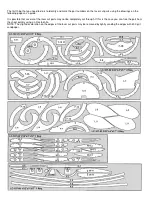
.
36. Lightly mist the model with water to shrink the tissue.
37.
Apply two coats of thinned dope to the entire model.
38.
Carefully apply the decal's to the model. Cut the paper motor from the plan and glue to the front of the cowl.
39.
Draw additional details on the model with a waterproof marker.
Final Assembly
40.
Glue the canopy into position on the model.
41.
Glue the wings into position on the model.
42.
Cut the paper wing fillets from the plan and glue them into position, one on top of the wing and one on bottom of each side.
Cover the fillets with tissue.
43.
Install the wheels and axles into the landing legs. Remove the tissue from the slots in the bottom of the wing and glue the
landing gear legs into position.
44.
Glue the stabilizer into the slot the fuselage making sure that it is aligned properly.
45.
Glue left and right elevators into position.
46.
Paint and then glue F-14 tail wheel into position.
47.
Attach the thread rigging to the model on the wing and the tail.
48.
Carefully glue the cowling into position on the fuselage.
49.
Assemble the propeller shaft and bearing with laminate pieces NB-1 (3/4" dia.), NB-2 (3/4" sq.) and NB-3 (5/8" sq.). Paint
this assembly black. Tie the rubber motor. Install the prop and motor, using the 3/32" dowel to retain the motor at the aft
end of the model.
50.
Balance the model at the points shown on the plan. Add weight to the nose or tail as required to achieve the proper
balance.
51.
Your model is now complete. You MUST READ AND FOLLOW all of the safety rules. We hope that you have enjoyed
assembling your model and hope that you enjoy many fine flights.
Your First Flights
1.
Make sure that all flying surfaces are straight and warp free.
2.
Wind the motor about 100 turns.
3.
Point the nose of the model into any gentle breeze that may be blowing.
4.
Release the propeller and after it starts turning gently toss the model aiming the nose at a point on the ground 100' in front
of you. Adjust the model to circle while increasing the number of turns in the motor. Adjustments can be made by gently
bending the tail surfaces and wing trailing edge.
5.
A properly trimmed model will circle to the left while climbing under power, level out as the power runs down and transition
into a right hand gliding circle.
























